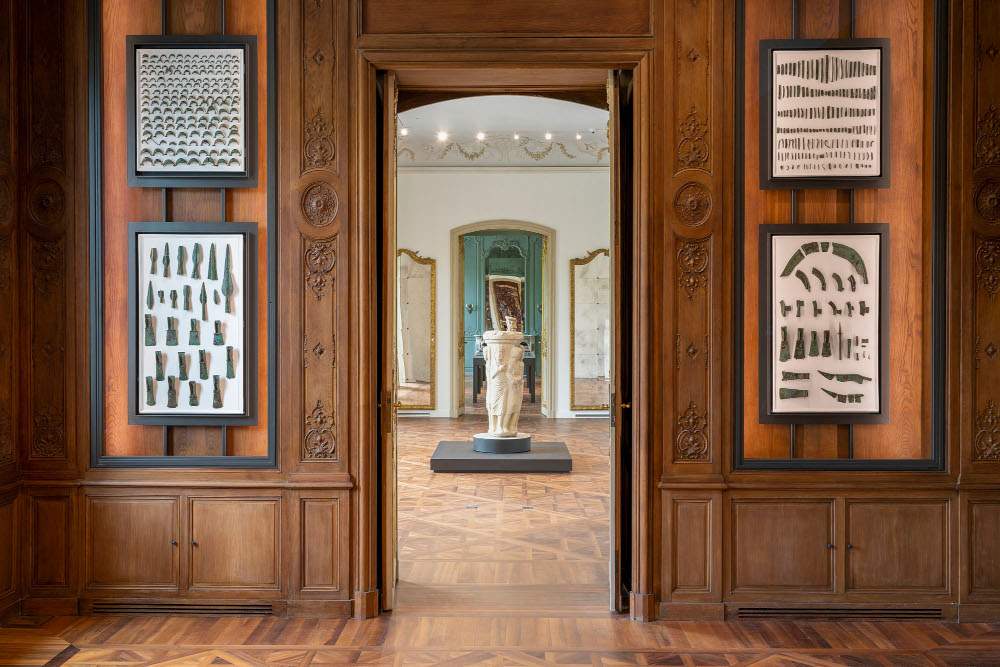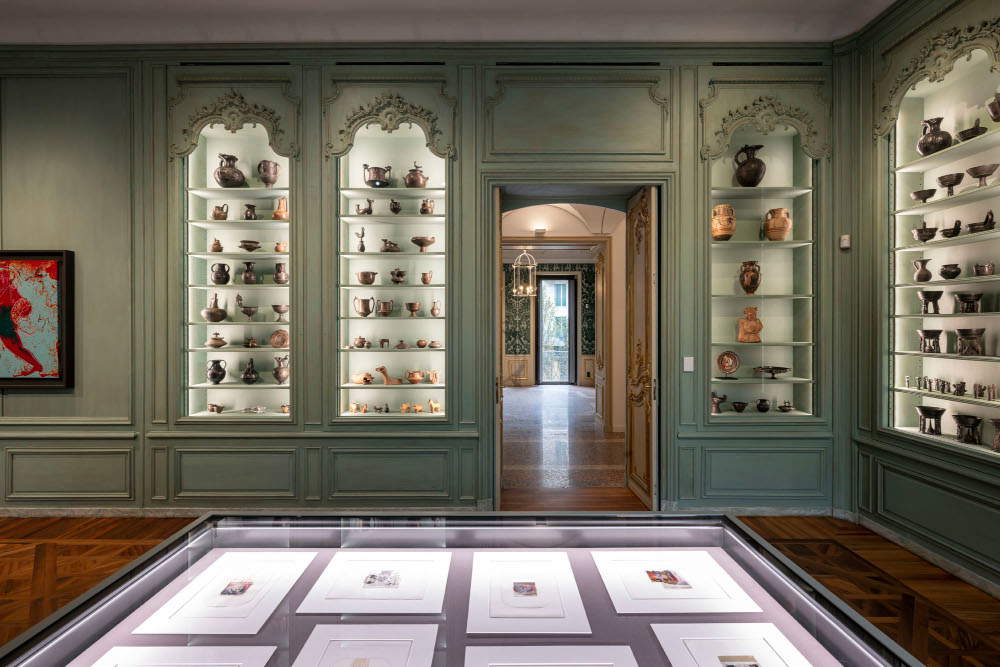The Luigi Rovati Foundation opens its Art Museum: two exhibition floors with more than two hundred and fifty works ranging from Etruscan art to contemporary art.
With the restoration, expansion and redevelopment of the building developed by MCA - Mario Cucinella Architects, the process of gradually bringing the Luigi Rovati Foundation closer to the public is concluded.
In the Hypogeum Floor, the stone architecture houses part of the path. One is greeted by a large travertine cinerary urn and moves inside the domes among the glass cases displaying large vases, votive offerings, antefixes, and small Etruscan bronzes alongside contemporary works by William Kentridge, Lucio Fontana, and Arturo Martini. From the domes to the large ellipsoidal hall, the exhibits tell the story of Etruscan daily life, and a vase by Picasso repurposes the image of the Etruscan banquet.
Next, in an intimate space is the Seeking the Beautiful section: small crystal cubes enclose jewelry, Etruscan jewelry and precious objects, such as Alberto Giacometti’s gilded bronze woman’s head. In the center, the largest display case houses the museum’s symbol, the Cernuschi Warrior, a fine Etruscan votive bronze. The section devoted to writing displays cinerary urns from Volterra and Chiusi and small ceramics that, thanks to new technologies, reveal the meaning of inscriptions.
The Children’s room, dedicated to educational workshops for children, reveals through the supporting architecture of the domes. In a small room, video-animations projected onto the stones narrate episodes from the history of the Etruscans.
From the Hypogeum Floor, the visit continues to the second floor, the Piano Nobile. From the paneling to the gilded doors, from the floors to the marble fireplaces, to the tall eighteenth-century mirrors in the corridor, all the rooms designed by Filippo Perego have been recovered, restored and redesigned. The canvas The Etruscan Scene: Female Ritual Dance (1985) by Andy Warhol, polaroids from the Etruscan series (1984) by Paolo Gioli, drawings and watercolors by Augusto Guido Gatti (1863-1947), evidence of the paintings found in the tombs of Tarquinia: these are some of the works that complement the seriality of the Etruscan buccheri enclosed in the showcases.
The tour continues in the other rooms, where works by contemporary artists such as Luigi Ontani, Giulio Paolini, Francesco Simeti, and Marianna Kennedy are displayed, placed in dialogue with Etruscan sculptures and artifacts. Alongside this ensemble are significant loans such as the extensive collection of axes, fibulae, and work tools from the Ripostiglio di San Francesco, from the Museo Civico Archeologico in Bologna, and Giorgio de Chirico’s large canvas Le Cheval d’Agamèmnon, (1929) from the Giuseppe Merlini Collection in Busto Arsizio.
“The different components of the installation aim to create a narrative continuum in the dialogue by oppositions or contiguities between ancient and contemporary, from the Hypogeum Floor to the Piano Nobile,” explains Giovanna Forlanelli, president of the Luigi Rovati Foundation, “and thus to give specific solicitations to the visitor who, as an emotional experience in addition to the artifacts and works, also visits the architectural spaces; they too, like the artifacts and works, in the continuous variation of form, light and color, are not containers but parts of the experience of the visit.”
“The Etruscan and contemporary art collections visible from Sept. 7 are the heart and gateway of the Luigi Rovati Foundation, but they do not exhaust its purposes,” continues Salvatore Settis, coordinator of the Foundation’s Scientific Committee. “Also part of it are the close ties with the city and its institutions, the offer of new spaces for multidisciplinary dialogue, and the centrality of ideas and activities related to social utility. A cultural planning that intends to deploy in each case the same level of quality and commitment that the works on display make evident to all.”
The spaces of the exhibition itinerary are designed to give the temporary exhibitions an integrated and well-defined reference platform that allows the public to find a renewed visiting experience each time. In particular, on the second floor the White Space and in the garden the Pavilion are dedicated to temporary projects.
In parallel, the Foundation develops research and study activities. Services and spaces have been designed for this purpose: among them, in addition to the study room located on the second floor, the second basement floor houses the Foundation’s entire Study Collection. A floor reserved exclusively for experts and researchers that, on special occasions, may be opened to the public.
The Foundation promotes access to knowledge by overcoming physical, cultural and social barriers, collaborating with professionals and nonprofit associations and organizations to develop paths and tools that facilitate access to the spaces and the relationship with the works. Starting in the fall, the facilitated guide of Museo per Tutti, a project conceived and implemented byAssociazione L’abilità onlus in collaboration with Fondazione De Agostini, will be available free of charge to visitors with intellectual disabilities. Museo per Tutti was created with the aim of making art and culture usable, especially to people who through their frailties may be able to experience emotions and understand works of art thanks to specially developed paths and languages. For visually impaired visitors, the Accessible Route for the Visually Impaired designed with the Institute of the Blind in Milan will be available, with 3D reproductions of a series of exhibits and a Braille guide.
From Sept. 7 to Sept. 30, admission is free.
For info: https://museo.fondazioneluigirovati.org/



 |
| Luigi Rovati Foundation museum opens, featuring more than 250 works from Etruscan to contemporary art |
Warning: the translation into English of the original Italian article was created using automatic tools. We undertake to review all articles, but we do not guarantee the total absence of inaccuracies in the translation due to the program. You can find the original by clicking on the ITA button. If you find any mistake,please contact us.